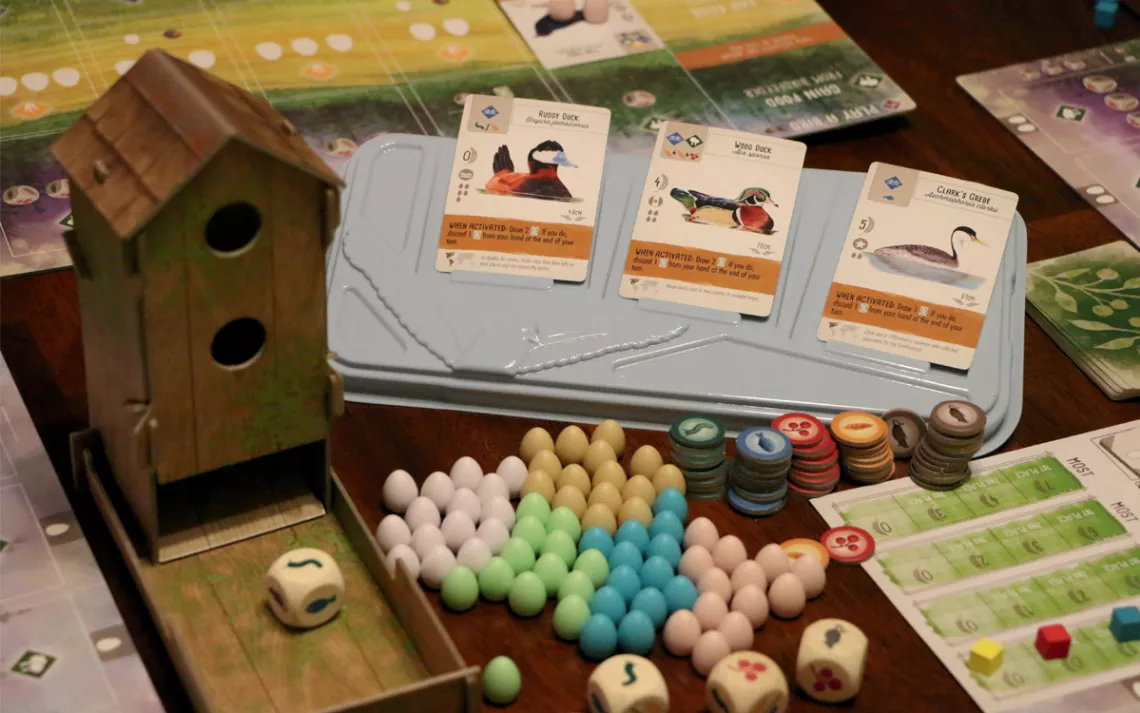Birdwatching Meets Board Game Night in Wingspan
Inside the hit game that's making hobby ornithologists out of gamers

The competitive, card-driven board game Wingspan has players vying to attract optimal birds to various ecosystems. | Photo by Kim Euker
At Elizabeth Hargrave's house, board game night used to mean journeying to distant realms with help from Castles of Burgundy and Race for the Galaxy. With all the wars, dragons, and spaceships, Hargrave says, it's no surprise that game design is a male-dominated field. "There were not a lot of board games about things that I was interested in."
What Hargrave was interested in was birds. The daughter of a biology teacher, she'd always been able to identify backyard birds, but a 2013 Costa Rica trip turned birding into a serious hobby. So, after long days working as a health policy consultant, Hargrave began to design the game she wanted to play—one that would satisfy the most demanding board gamers yet be easy enough for non-gaming birders to pick up.
That game was Wingspan. Published by Stonemaier Games last year, Hargrave's hit creation combines strategy with scientific accuracy—and lets players explore a fascinating realm a little closer to home.
Like Settlers of Catan and Monopoly, Wingspan is an engine-building game. In this case, that engine is a bird ecosystem: Each player starts with a board featuring forest, grassland, and wetland and populates their habitats using the 170 bird cards in the deck, each of which features a hand-drawn North American bird along with species information. On each turn, players must maximize life for birds in their habitats—and points for themselves—by drawing additional bird cards from the deck, laying eggs for their existing birds, or finding them food.
The union of birds and board games wouldn't seem to suggest a blockbuster, but on the day of Wingspan's release, Stonemaier Games issued an apology: The first printing had sold out. Before year's end, the game had sold over 200,000 copies and snagged the coveted Kennerspiel des Jahres, a top industry award for strategy board games.
Wingspan took off at a strange time. While the coronavirus pandemic sparked demand for complex, engaging games—Catan sales rose by 144 percent in the first half of 2020—many game developers struggled to stay afloat as conferences were canceled and game stores temporarily closed. And despite gamers' valiant efforts, Zoom can't quite replicate the joy of playing in person, Hargrave says. "This is a thing that brings us together, when we're not looking at our screens and are actually interacting as human beings."
As the pandemic took hold and homebound people around the world sought refuge in nature, interest in birdwatching exploded. The Cornell Lab's annual Global Big Day in May shattered records as more than 50,000 birdwatchers worldwide submitted sightings. With Wingspan, bird fans found that they could bring that passion indoors and commune over a typically solitary hobby.
Lindsay Grossman, the president of Indiana's South Bend–Elkhart Audubon Society, would know. When the avid gamer pulled the card featuring the brown-headed cowbird—notorious in the avian community for abandoning its eggs in other birds' nests—Grossman immediately understood that Wingspan took birds seriously. "Because in the game, too, you cannot simply lay eggs on the cowbird's card—you have to lay them on another bird on your board." She's used Wingspan to introduce friends to her two passions and loves when they begin to identify birds after playing.
This year, Stonemaier Games is releasing Wingspan expansion packs featuring birds native to Europe and Oceania. (Hargrave's new game about butterflies, Mariposa, was also released.)
Ideal for long winter nights when the birds have flown south, Wingspan is a portal into a secret yet very real world. And come spring, when songbirds once again paint the sky, its players will know to look up.
This article appeared in the November/December 2020 edition with the headline "Wild Game."
 The Magazine of The Sierra Club
The Magazine of The Sierra Club



